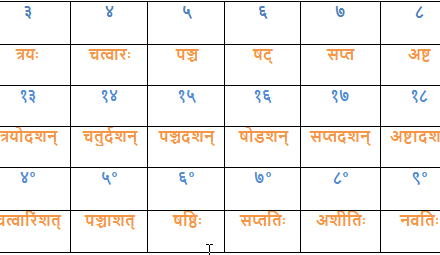This is the last part of pronouns. With this section will complete our study on pronouns completely. The pronoun that we are going to study her is called idam, it is one of the most irregular pronouns in Sanskrit, which uses different stems for each gender.
ayam (masculine)
| अयम् | Singular | Dual | Plural |
|---|---|---|---|
| Case 1 (Subject) | अयम् ayam | इमौ imau | इमे ime |
| Case 2 (object) | इमम् imam | इमौ imau | इमान् imān |
| Case 3 ("with") | अनेन anena | आभ्याम् ābhyām | एभिः ebhiḥ |
| Case 4 ("for") | अस्मै asmai | आभ्याम् ābhyām | एभ्यः ebhyaḥ |
| Case 5 ("from") | अस्मात् asmāt | आभ्याम् ābhyām | एभ्यः ebhyaḥ |
| Case 6 ("of") | अस्य asya | अनयोः anayoḥ | एषाम् eṣām |
| Case 7 ("in") | अस्मिन् asmin | अनयोः anayoḥ | एषु eṣu |
iyam (feminine)
| इयम् | Singular | Dual | Plural |
|---|---|---|---|
| Case 1 (Subject) | इयम् iyam | इमे ime | इमाः imāḥ |
| Case 2 (object) | इमाम् imām | इमे ime | इमाः imāḥ |
| Case 3 ("with") | अनया anayā | आभ्याम् ābhyām | आभिः ābhiḥ |
| Case 4 ("for") | अस्यै asyai | आभ्याम् ābhyām | आभ्यः ābhyaḥ |
| Case 5 ("from") | आस्याः asyāḥ | आभ्याम् ābhyām | आभ्यः ābhyaḥ |
| Case 6 ("of") | आस्याः asyāḥ | अनयोः anayoḥ | आसाम् āsām |
| Case 7 ("in") | अस्याम् asyām | अनयोः anayoḥ | आसु āsu |
You must have noticed two things here,
- The dual case in case 3 and 7 are similar to that of ayam’s dual form
- The plural form in cases 3 and 7 are identical to that of ayam’s plural form
The difference can be seen only in the first vowel which is e for the masculine and ā for the feminine
idam (neuter)
| इयम् | Singular | Dual | Plural |
|---|---|---|---|
| Case 1 (Subject) | इदम् idam | इमे ime | इमानि imāni |
| Case 2 (object) | इदम् idam | इमे ime | इमानि imāni |





